Coffee beans roasting detailed analysis-a good coffee must-see knowledge
Coffee roasting is a process of high temperature decomposition (Pyrolysis), which completely changes the substance inside the raw bean, produces new compounds, and recombines to form aroma and mellow flavor. This effect only occurs at high temperatures, and decomposition cannot be caused if only low temperatures are used.
In fact, in the coffee processing process, baking is the most rare step, it is a kind of science, but also a kind of art. The baking process is divided into three stages:
Dehydration, in the early stage of baking, raw beans begin to absorb heat, and the water inside gradually evaporates. This is, the color gradually changed from cyan to yellow or light brown, and the silver skin began to fall off, you can smell the faint smell of grass. The main function of this stage is to remove water, but the baker will make good use of the temperature of the water and control it properly so that it will not evaporate too quickly. When the water reaches the boiling point, it turns to steam, when the internal material is fully heated, and the water begins to evaporate, draining the outside of the beans.
Decompose at high temperature, bake to about 160 degrees, the water inside the bean evaporates into gas, and begins to discharge the outside of the coffee bean. At this time, the interior of the raw bean changed from endothermic (Endothermic) to exothermic (Exdothermic), and the first burst sound appeared. After the first burst, it turns to endothermic again, when the internal pressure of the coffee bean is extremely high, up to 25 atmospheric pressure. Heat and pressure begin to deconstruct the original tissue to form new compounds that create the taste and taste of coffee. When it reaches about 190 degrees, the conversion between endothermic and exothermic occurs again. Of course, high temperature cracking continued to occur, coffee beans changed from brown to dark brown, and gradually entered the stage of heavy roasting.
Cooling (Quenching), coffee must be cooled immediately after roasting, quickly stop the high temperature cracking, and lock the flavor. Otherwise, the high temperature in the beans will continue to act and will burn off the aromatic substances. There are generally two cooling methods, one is air-cooled, the other is water-cooled. The air-cooled type is slow, but it is clean and does not pollute, and it can retain the mellow flavor of coffee, so it is used for fine coffee. Water-cooled coffee beans are sprayed with a layer of water mist on the surface of coffee beans, causing the temperature to drop rapidly, requiring precise calculation, and increasing the weight of roasted coffee beans, generally used in commercial coffee roasting.
Burst sound, raw beans from endothermic to exothermic, the internal gas out of the body, will form an obvious sound. The first time is louder, crisp and scattered, and the second is quiet, meticulous and concentrated. Because of the high correlation between popping sound and temperature, it can fully represent the baking temperature, which is an important basis for bakers to judge the baking degree.
The changes caused by baking are very complicated, and although scientists continue to study and analyze them, they are still unable to get a glimpse of the whole picture. There are roughly the following changes:
Weightlessness: the moisture content is reduced from about 13% to 1%, and the weight loss rate is about 12% 21%. The higher the baking degree, the more weightlessness.
Volume expansion: after baking, the volume of coffee beans will increase by more than 60%.
Pore enlargement: the cell wall of raw bean is hard and the cell pore is closed, so it is not easy to deteriorate. But after baking, the cell wall becomes fragile, the cell pore is enlarged, and it is easy to lose the internal material.
Formation of carbon dioxide: high temperature decomposition causes the carbohydrates inside the coffee bean to decompose and combine with other substances to form a large amount of carbon dioxide, which resides inside the coffee bean.
Change the organizational structure: after baking, carbohydrates dropped sharply from 58.9% to 38.3%, and acids (fatty acids, tannins, chloric acid, etc.) decreased from 8.0% to 4.9%. Under the action of high temperature pyrolysis, these substances are reorganized and transformed into caramel, carbon dioxide and some volatile substances. Among them, caramel accounts for 25% of the quality of roasted beans, forming the sweet taste of coffee. Fat accounts for 16.2% of raw beans and increases to 17% after baking, which is the source of mellow taste and consistency. Caffeine levels barely changed. Therefore, the bitterness of re-baked coffee does not come from caffeine.
Baking degree, Pacific region differentiation method:
Light Roast (light baking): it still has the smell of grass, no aroma and mellow taste.
Cinnamon Roast (cinnamon roasting): coffee beans turn cinnamon.
Medium Roast (medium baking): has a strong sour taste.
High Roast (High Color Baking): sour, bitter and sweet begin to strike a balance.
City Roast (city baking): baked to the first explosion, just about to enter the second burst sound.
Full City Roast (city-wide roasting): when the second explosion is in progress, it is a favorite of select coffee roasters.
French Roast (French baking): very bitter.
Italian Roast (Italian roasting): the raw material of Italian espresso.
The National Fine Coffee Association (SCAA) uses Elon instruments to determine and analyze the color of coffee and the degree of caramel coking. Set black to 0 and white to 100, which is divided into 8 equal parts, representing 8 baking levels.
Important Notice :
前街咖啡 FrontStreet Coffee has moved to new addredd:
FrontStreet Coffee Address: 315,Donghua East Road,GuangZhou
Tel:020 38364473
- Prev

A brief introduction to the mocha pot-the fundamentals of the introduction of baristas
Today, when Italian coffee is popular all over the world, we are no stranger to Italian coffee machine, and even passers-by can name several Italian fancy coffee. But today we have more criticism and discrimination against the mocha pot, and we always question whether the coffee made by mocha is Espresso. In Italy, more than 90% of families own more than one family.
- Next

What you need to know about origin, roasting and extraction-the basics of coffee
Origin: Highland coffee is superior in the three major coffee beans, players are after Arabica beans. This is because highland coffee is better than lowland coffee. Therefore, when commenting on the quality of coffee, the height of the origin is often included in the evaluation criteria. The higher the altitude and the lower the relative temperature, the coffee fruit can ripen slowly, so the fully ripe beans expand.
Related
- What is the meaning of lactic acid fermentation with coffee bean treatment?
- How to judge the state of foam by sound?
- How does the latte pull out the unicorn pattern? Come to get for a little trick to improve the flower pull!
- Will flower pulling affect the taste of the latte?
- Do you know the history of coffee?
- The difference between honey treatment and sun washing what is raisin honey treatment?
- What kind of milk can a novice use to make coffee foam to keep the foam longer? The correct method and skills of milking tutorial sharing
- Why do washed coffee beans taste sour? Flavor characteristics of washed Coffee
- Introduction to the skill of how to practice the size and height of water injection around the circle of hand-brewed coffee
- How do beginners practice coffee flower drawing from scratch?

